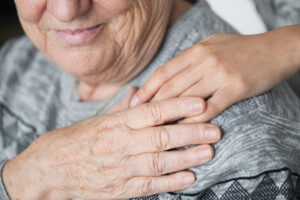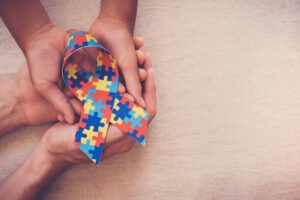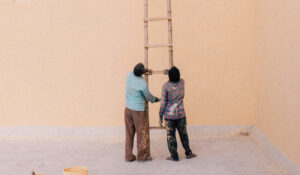
The window of the soul: From connection to protection and back

By poet and scientist alike, the face (and in particular the eyes) is considered the window of the soul, allowing us to look outside us, while others, in turn, “read” our facial expressions as best they can (with the help of motor neurons that “mirror” what is observed) and assess our internal weather, our feelings and state of mind. The human face harbors five cranial nerves, whose roots converge in the brainstem to create an integrated social engagement system—these consist of the trigeminal, facialis, glossopharyngeal, accessory and vagal nerves.
Outside our conscious awareness, in order to protect us, the neurological perception or neuroception of safety and danger is constantly on high alert for cues of safety or danger. As we habitually scan our environment and tune in to signals of safety or danger (both verbal and nonverbal), we instinctively know whether to approach someone or distance ourselves from them. We take in the other’s body language, gestures and facial expressions, even from a distance. On this basis, as well as based on internal signals from our gut feelings, we encourage or discourage physical proximity, social engagement and closeness.
Since connection is a biological imperative, and the autonomous nervous system (ANS) is a relational system, we are wired for connection. We communicate through our eyes, our tone of voice, our facial expressions and gestures. We learn to discern among cues for safety and danger, connection and protection.
Since the evolutionary emergence of the ventral vagal system millions of years ago, we can regulate our autonomous nervous systems via the connections we form with others in face-to-face interactions.
Thus, the mammalian social engagement system is a two-way communication hub, busily sending and receiving information relevant to connection. An embodied (physical) sense of safety requires both the resolution of cues of danger and concomitantly, the experience of cues of safety (e.g., a welcoming smile, a soothing sound). In connecting with others, we can often create a shared sense of safety and community.
Three neural circuits
There are three autonomous nervous system (ANS) states, each of which has adaptive value (Porges, 2003). During the day, we move up and down the evolutionary ladder of these neural pathways i.e., the ventral vagal, sympathetic and dorsal vagal circuits. Each circuit represents a specific response to cues of safety and danger.
The ventral vagal pathway from the heart connects with pathways that control muscles of the face and head, regulating how we turn and tilt our head to smell, see, hear, speak and express emotion. This has been named the “face-heart connection” (Porges, 2003).
The ventral vagus connects with the heart’s pacemaker (sinoatrial node), which regulates the rhythms of the heart, can make it step up its pace or slow down. In fact, this function has been called the ventral brake. A flexible ventral brake allows ease in transit from one state to another, and one can rapidly engage and disengage, energize and calm, in a purposeful way. Instead of merely reacting, one can reflect and choose how to best respond to a given challenge or situation (Dana, 2020).
Like most systems, the ventral vagal system can be taxed beyond its limits by a feeling of overwhelm, whether at work, family, relationship and/or a sense of loneliness.
When mobilization by the sympathetic system with its action programs of “Fight or Flight” cannot resolve or ameliorate one’s distress, if there aren’t enough resources available, the ANS may collapse into an experience of dorsal vagal lifelessness, in which we retreat to an energetic conservation mode, functioning at a bare minimum. (This is when we decide to crawl back into bed and hide under the blanket, binge mindlessly on a Netflix series, or retreat into sleep.) The dorsal vagal response is a response to what appears inescapable, and is thus characterized by disconnection and numbing, and even dissociation.
Upon subsequently moving out of the dorsal vagal mode, there is a surge of sympathetic energy (i.e., a return to the Fight or Flight modes), but without a regulating influence, it may be too much and flood the system, leading back to a return to dorsal vagal shutdown.
Modulating factors that may prevent this shutdown include both inner and outer resources, such as a connection to another person, or an organized way to use or channel the energy. (The latter may include the conscious utilization of dance or the practice of Qigong.)
Since the ability to return to regulation is the essence of resilience [1], it is important to be able to access and strengthen pathways to ventral vagal regulation, which include those of co-regulation. A regulated person in our immediate vicinity is an invaluable resource, allowing us to take a much needed deep breath and calm down a bit.
Sometimes, however, we may be lulled safety when, in fact, we are not safe, remaining unaware of the danger lurking around the corner; conversely, we may see danger where it is not. For example, as recently described on a documentary on the Mossad (Channel One), an undercover agent, constantly on the lookout for signs of danger and life-threat, may become overly paranoid and overreact, becoming a danger to himself and others. Conversely, a survivor of sexual abuse may be less than optimally alert to danger in a social situation.
Often these faulty “neuroceptions” are due to traumatic experiences that have not been adequately processed, and alert us that the nervous system needs to be recalibrated. This reset is possible via SE or EMDR therapy, both of which are thought to favor a “bottom-up” approach (as opposed to a “top-down” one.) The processing is done primarily by sub-cortical structures (e.g., the ANS and amygdala, limbic system) informing the neocortex via afferent pathways.
Examples of polyvagal exercises for safety and connection
Porges and in his wake, Dana, describe neural exercises that can help us maintain ventral vagal safety [2]. Although instinctively, our bodies know just what to do, sometimes we need to remind them of it.
Fortunately, because of the way brain networks reorganize (neuroplasticity) autonomic patterns can be modified and ongoing experiences can reduce or even resolve cues of danger. Moreover, one can learn to notice cues of safety hitherto embedded in cues of danger, and thus overlooked.
How do we achieve this?
According to Porges, as information reaches the brain and we enter an autonomic state, the physiological state creates a psychological story—a story is created to make sense of the physiological experience and give it meaning (Dana, 2020).
Neuroperception > perception > ANS state > feelings > behavior > story [3].
Story begins in the ANS, far away from the thinking brain (neocortex), with a neuroception of safety, danger, life-threat.
IF you can leave behind the story, behavior and feelings, to identify the ANS state and bring perception (a conscious process) to neuroception (an unconscious process), then you can become aware of what is triggering you, of “how your internal surveillance system begins the sequence of events and eventually leads to the way you are feeling, acting and thinking.” (Dana, 2020, p. 24).
According to Dana (2020), we can “bring perception to neuroception and then add context through the lens of discernment.” (p. 22) In other words, we can consider whether the old cues of danger from the past are still valid or necessary, in the here and now.
Perhaps you can learn to ask yourself whether, “In this moment, with this person, in this place, surrounded by these things, are you actually in danger, or are you safe?” (p. 23).
Our personal story is a function of whether, growing up, we’ve had (and/or currently have) regulated and regulating people around us. We all depend on co-regulation, that is, autonomic, face-to-face, nervous system-to-nervous system regulation—first apparent between mother and child as they bond together. In the dyad, there is a shared autonomic experience, a shared emotional experience and a shared experience of safety (Dana, 2020). Ideally, the infant/child is able to internalize this co-regulation (part of secure attachment) and eventually regulate himself on his or her own. However, “no man is an island,” and we all need a certain amount of co-regulation, no matter how old we are or where we are with our lives.
Since a nuanced attunement cannot be maintained all the time, what actually occurs after a mismatch, when it was lacking, is of critical import. This holds true both in relationships with early caregivers and in subsequent relationships with significant others. Can the inevitable ruptures be recognized, addressed and repaired? When this happens, the connection is strengthened.
Exercise 1: Identifying the state of your ANS and practicing focusing on safety and connection
Learn to identify in which ANS state you are, whether ventral vagal safety and connection, sympathetic mobilization, or dorsal collapse (see previous article, in this regard).
During the day, it is natural that you will move from one to the other. In fact, you can draw a daily “pie chart” and map out the relative valence of each state during that particular day (Dana, 2020). Some days will have more “safety and connection” in them than others, and you can learn to create such micro-moments.
Focus on micro-moments of safety and connection and sense where in the body you feel them. Notice your breath, muscle tone and posture. Track the flow of energy. Are there any bodily movements your body wants to make? If so, simply notice them.
As you persevere in this endeavor and make a habit of noticing these micro-moments (which Dana calls ‘glimmers’), they will gradually accumulate and provide an island of respite during the day. This will promote your resilience by allowing you to refuel and go on. Eventually, you may be able to tip the scale in favor of ventral vagal safety and connection, if you start elsewhere along the ANS ladder.
You can also learn to track the ways your body signals it is discharging tension as you move toward safety and connection, leaving behind the energetic mobilization of “fight and flight” (a sympathetic state), or perhaps the immobilization of “freeze and collapse” (a dorsal vagal state).
These spontaneous bodily signals of discharge include: a deep breath or sigh, yawning, a light shaking or trembling, a gentle sweat on one’s limbs, and more.
Exercise 2: A ventral vagal space to call your own
Especially now, during the “new normal” of Corona time, many of us spend much time at home. It is worthwhile to identify what brings you joy in your indoor environment, creating spaces that nourish your nervous systems. (You may watch Marie Konu’s series on Netflix to inspire you.)
Our external milieu has cues of safety and invigorating energy, as well as areas that may create a sense of discomfort or disarray.
Look around you and identify which spaces in your home fill you with joy and energy, feel friendly and safe. What is it about them that makes them feel comforting and connecting?
Are there objects that you find activating in some way, that trigger your sympathetic or dorsal vagal systems? Can you do something about them?
(I recently chucked out some old DVDs attracting dust on a bookshelf in the living room).
As you identify the places and objects in your home that inspire a feeling of safety and well-being, of connection, notice which qualities feel regulating and nourishing to your nervous system?
Small changes can make a big difference. For example, I recently placed a small flowery fern in a lilac-colored vase on the bathroom counter, and it fills me with joy every time I see it there.
Imagine the real, and look for spaces at home (or work) that could become what Dana calls “a source of ventral vagal inspiration.”
Minor changes add up to a tipping point that may allow you to move from one ANS state to another. Make a habit of tracking your autonomic response to each change. Notice how it feels in the body.
So—this is the time to go find objects that energize your ventral vagal system and make it dance.
References
Dana, D. (2020). Polyvagal Exercises for Safety and Connection. New York: Norton.
Porges, S. W. (2003). Social engagement and attachment. Annals of the New York Academy of Sciences, 1008, 31-47.
1. see website articles on resources and resilience and the polyvagal theory
2. See my account of “the green zone”, in a previous article on the subject.
3. This conception is similar to Peter Levine’s concept of SIBAM, for those of you interested in SE.









